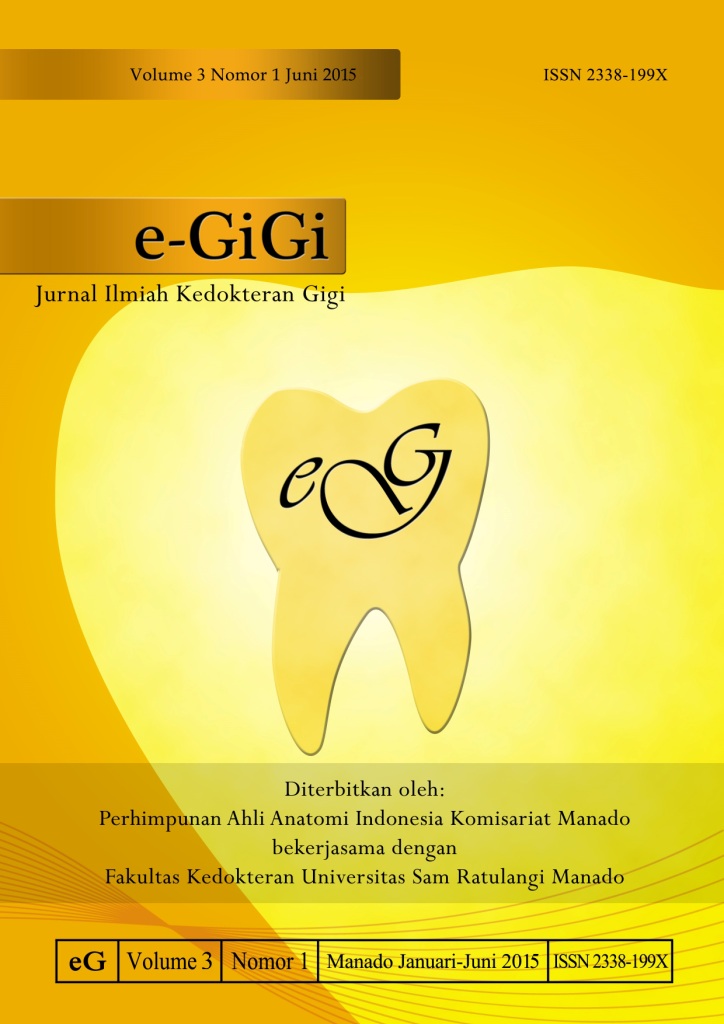HUBUNGAN TINGKAT KECEMASAN DENGAN PERUBAHAN DENYUT NADI PADA PASIEN EKSTRAKSI GIGI DI PUSKESMAS TUMINTING MANADO
DOI:
https://doi.org/10.35790/eg.3.1.2015.6399Abstract
Abstract: Dental practice surely will always be accompanied by patient’s anxiety. The anxiety itself is manifested through many ways. The physiological symptoms may occur, from the increasing pulse rate or excessive sweating. The objective of this research is to find out the relationship between the level of anxiety and the changes in the pulse rate of the patients who undergo tooth extraction. The methodological used in this study is descriptive and analytical from a cross sectional study performed in Puskesmas Tuminting Manado from 11 September to 1st October 2014. The population and sample were derived from the entire patients who visit Puskesmas Tuminting and undergo tooth extraction. The sample was drawn from the entire population according to specified inclusion criteria. The data was collected from questionnaires with Hamilton Anxiety Scale and the measurement of patient’s pulse rate was performed during the waiting time and tooth extraction preparation. The data was computed by using SPSS Program version 20 and analyzed through univariate and bivariate Spearmen analysis. The result shows that patients who undergo tooth extraction were experiencing anxiety and the patients’ pulse rate were increasing accordingly. The range of 31-40 years old were the highest age group who were experiencing anxiety and female experienced the highest level of anxiety. The relationship between anxiety and the changes in the pulse rate from the statistical study shows p value = 0.703, hence Ha is rejected. Conclusion: is there is no relationship between level of anxiety and the changes of pulse rate on the patients who undergo tooth extraction in Puskesmas Tuminting, Manado.
Keywords: anxiety, pulse rate, tooth extraction
Abstrak: Praktik Kedokteran Gigi tentunya tidak lepas dari kecemasan yang dialami oleh pasien. Kecemasan dapat bermanifestasi dalam berbagai cara. Tanda-tanda fisiologis yang dapat timbul, ditandai dengan meningginya denyut nadi atau berkeringat. Tujuan penelitian ini yaitu mengetahui hubungan tingkat kecemasan dengan perubahan denyut nadi pada pasien ekstraksi gigi di Puskesmas Tuminting Manado.Penelitian ini merupakan penelitian deskriptif analitik dengan pendekatan potong lintang (cross-sectional study) yang dilakukan di Puskesmas Tuminting Manado pada tanggal 11 September - 1 Oktober 2014. Populasi dan sampel ialah seluruh pasien yang berkunjung di Puskesmas Tuminting dan melakukan tindakan ekstraksi gigi yang berusia di atas 17 tahun serta sudah pernah melakukan ekstraksi gigi. Teknik pengambilan sampel menggunakan total populasi sesuai kriteria inklusi. Data diambil menggunakan kuesioner Hamilton Anxiety Scale dan pengukuran denyut nadi dilakukan saat menunggu dan saat berada di kursi dental sebelum tindakan ekstraksi gigi. Data diolah dengan menggunakan program SPSS versi 20 dan dianalisis menggunakan analisis univariat dan bivariat menggunakan uji Spearmen.Hasil penelitian menunjukkan dalam tindakan ekstraksi gigi terdapat pasien yang mengalami kecemasan dan terdapat pasien yang mengalami peningkatan denyut nadi. Usia 31-40 tahun merupakan usia terbanyak yang mengalami kecemasan serta jenis kelamin perempuan paling banyak merasa cemas. Hubungan antara kecemasan ekstraksi gigi dengan perubahan denyut nadi dari hasil uji statistik diperoleh nilai p = 0,703 maka Ha ditolak. Simpulan: tidak terdapat hubungan antara tingkat kecemasan dengan perubahan denyut nadi pada pasien ekstraksi gigi di Puskesmas Tuminting Manado.
Kata kunci: kecemasan, denyut nadi, ekstraksi gigi
Downloads
Published
How to Cite
Issue
Section
License
COPYRIGHT
Authors who publish with this journal agree to the following terms:
Authors hold their copyright and grant this journal the privilege of first publication, with the work simultaneously licensed under a Creative Commons Attribution License that permits others to impart the work with an acknowledgment of the work's origin and initial publication by this journal.
Authors can enter into separate or additional contractual arrangements for the non-exclusive distribution of the journal's published version of the work (for example, post it to an institutional repository or publish it in a book), with an acknowledgment of its underlying publication in this journal.
Authors are permitted and encouraged to post their work online (for example, in institutional repositories or on their website) as it can lead to productive exchanges, as well as earlier and greater citation of the published work (See The Effect of Open Access).






